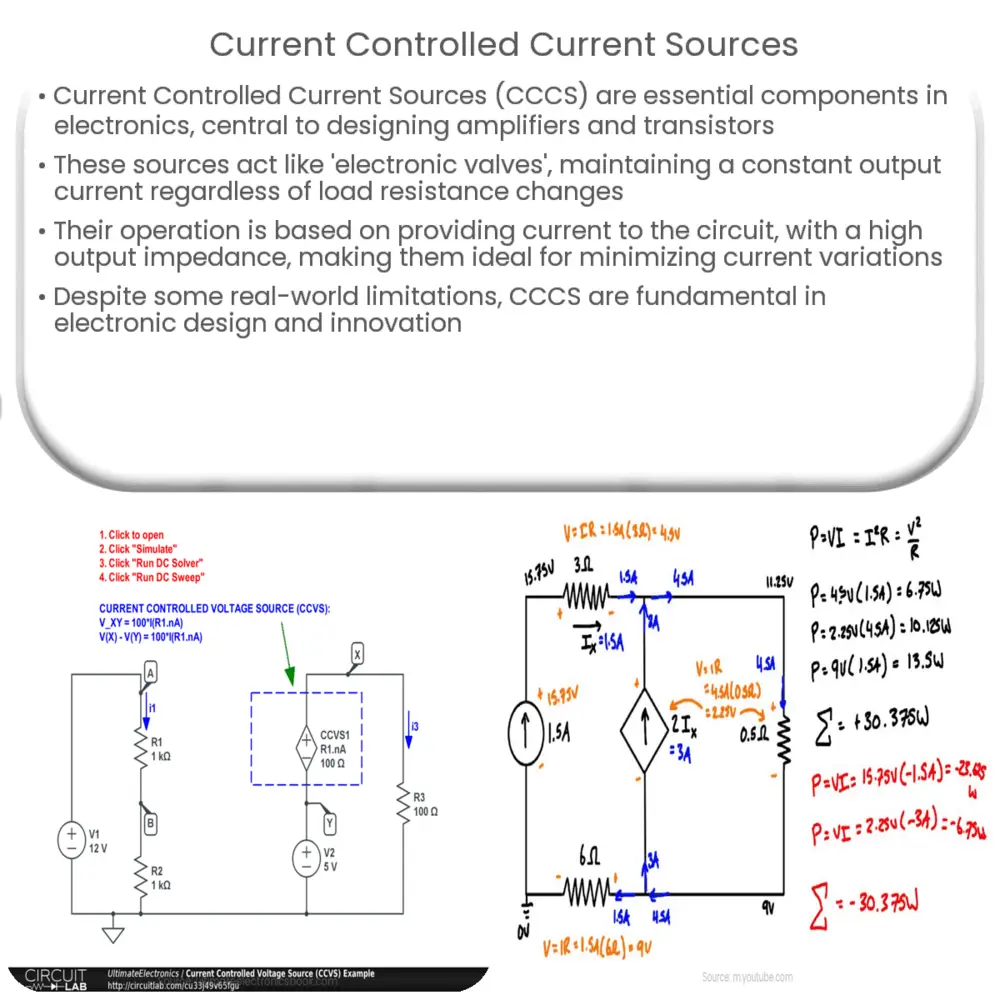Explore the world of

Introduction to Current Controlled Current Sources
A Current Controlled Current Source (CCCS) is an essential component in electronics, often used in a variety of electronic circuits and systems. This active two-port network element is characterized by an output current that is directly proportional to the input current flowing through it, signifying its ‘controlled’ nature. CCCS are pivotal in designing amplifiers, transistors, and other electronic devices.
Theoretical Overview of Current Controlled Current Sources
In the realm of electronic circuits, current controlled current sources can be likened to an ‘electronic valve’ of sorts. It controls the amount of current that passes through a particular path in a circuit. The mechanism of a CCCS lies in its ability to maintain a constant current output, despite variations in load resistance. This current is proportional to the controlling current, and the factor of proportionality is known as the ‘current gain’ or beta (β).
- Input Current (Ii): The current flowing into the controlling port.
- Output Current (Io): The current flowing out of the controlled port.
- Current Gain (β): The ratio of output current to input current (β = Io / Ii).
Working Principle of CCCS
The operation of a CCCS is founded on the principle that it sources, or ‘provides’, current to the circuit. This is derived from an input current source, ensuring the output current (Io) equals the input current (Ii) multiplied by the current gain (β).
One of the major features of CCCS is its high output impedance. This means it exhibits a relatively high voltage difference across its terminals for a slight change in current. Therefore, it is an ideal current source as it successfully minimizes current variations across a broad range of load resistances.
In application, it is typical for a CCCS to work in tandem with other circuit components. These include resistors, capacitors, diodes, and other transistors, contributing to a circuit’s overall operational efficiency. Whether it’s signal amplification in transistors or active filter implementation, the role of a CCCS is indeed quite versatile.
Applications of Current Controlled Current Sources
Current controlled current sources find widespread usage in various fields, underlining their significance in electronics. Some notable applications are listed below:
- Operational Amplifiers (Op-Amps): CCCS are vital in constructing operational amplifiers, where they are used to control the flow of current, thus impacting the gain of the Op-Amp.
- Active Filters: CCCS are employed in active filters, specifically in the implementation of integrators and differentiators which are critical components of these filters.
- Impedance Matching: In RF circuits, CCCS can be used to match impedances to maximize power transfer, thus enhancing the efficiency of the circuit.
- Current Mirrors: A crucial application of CCCS is in the creation of current mirrors, which are used to provide constant bias currents in differential amplifiers and other analog circuits.
Limitations and Practical Considerations
Despite their utility, CCCS have some limitations. Real-world CCCS cannot provide an infinite output impedance, meaning the output current may vary slightly with changing load conditions. Moreover, CCCS are affected by temperature fluctuations, which can impact their performance.
From a design perspective, it’s important to bear in mind that while ideal CCCS can’t be practically realized, they are useful in theoretical analysis and design of electronic circuits. Real-world CCCS are designed and implemented using transistors and operational amplifiers, and the difference between the ideal and practical models must be accounted for in high precision applications.
Conclusion
In conclusion, current controlled current sources play a critical role in the domain of electronics, aiding in the design and operation of numerous electronic circuits and systems. Their mechanism, underpinned by the regulation of current flow and high output impedance, enables a variety of applications, ranging from operational amplifiers to impedance matching in RF circuits. Despite some inherent limitations in real-world scenarios, CCCS continue to be indispensable components in electronic design and innovation. Understanding the principles of CCCS is instrumental in paving the way for more efficient and reliable electronics, driving progress in this continually evolving field.

